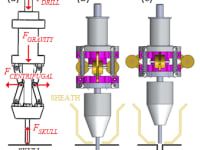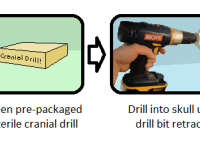
The PROBLEM
Penetrating the skull to measure intracranial pressure is an important intervention for diagnosing raised intracranial pressure following head trauma. Studies show that 1.7 million people suffer from head injury annually in the U.S., totaling $60 billion in costs. 275,000 of those injured annually are hospitalized and 52,000 will eventually die as a result of that injury. The risk of pressure induced damage can be reduced by penetrating the skull with a small diameter hole and draining excess fluid or placing sensors inside the skull for pressure monitoring. Although frequent monitoring has been correlated with a decrease in mortality rates, only a small percent of patients receive intracranial pressure (ICP) monitoring due to the lack of availability of a sufficient number of neurosurgeons.
The SOLUTION
We have developed a patent-pending device that enables non-neurosurgical personnel to safely drill through the skull without the risk of additional brain damage. It consists of a handheld, portable, cranial drilling device that can be used with any diameter drill bit to create holes in the skull without traumatizing underlying brain tissue. The device relies on a dynamic bi-stable mechanism that supports drilling when force is being applied to the drill, but retracts inside a protective sheath when the force is reduced on penetrating the skull. The bi-stable mechanism is activated by centrifugal forces (due to drill rotation) that cause the linkages to change from the drilling position to the collapsed position at the moment of skull penetration. Initial testing on ex-vivo animal structures has verified that the retraction mechanism successfully removes the drill bit before damaging soft tissue beneath the skull. A reload mechanism allows the user to reset the device to the drilling position and create additional holes.
The OPPORTUNITY
The device is designed to access the brain in the emergency room, disaster relief, or in military settings. It is safe, portable, and versatile. Due to its safety features a general surgeon could operate the device, greatly increasing the availability of pressure monitoring for head trauma patients. Additionally, although this device was designed for cranial neurosurgery, the mechanism can also be used to increase safety in other drilling procedures. Our device can drill holes for inserting screws into the vertebrae, pelvis, or puncturing the sternum to access the pericardium while avoiding damage to delicate organs, nerves, or blood vessels.
-
Awards
-
 2012 Top 100 Entries
2012 Top 100 Entries
Like this entry?
-
About the Entrant
- Name:Paul Loschak
- Type of entry:teamTeam members:Paul Loschak
Kechao Xiao
Hao Pei - Software used for this entry:SolidWords
- Patent status:pending








